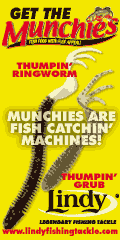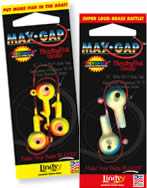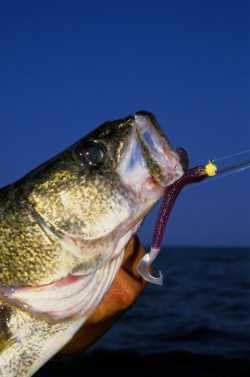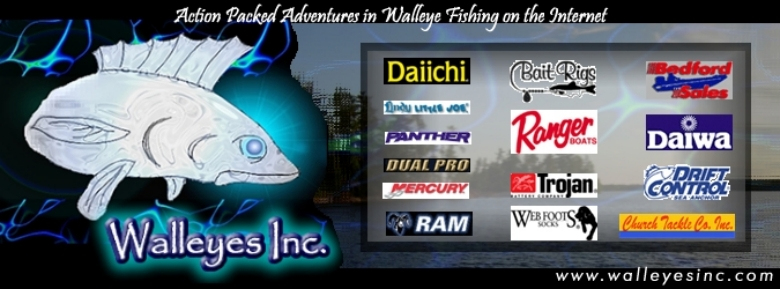 |
Soft plastics are great for catching walleyes any time
of year. But walleye pro Eric Olsen of the Lindy Fishing
Team likes them especially in fall and spring. Soft plastics
lures, like the new Lindy Munchies Thumpin’ Ringworm can
be cast farther than live bait to avoid spooking fish
in the shallows, he said. Cut-tail baits like the Munchies
Thumpin’ Grub don’t require much action to make them work.
An angler who is vertical jigging doesn’t have to pump
them radically to make them work. That means the bait
can spend more time in the strike zone. "That’s the coolest
thing," he said. In walleye hot spots like the Mississippi
River near Olsen’s home of Lake Pepin or lakes like Mille
Lacs, walleyes will congregate on shorelines featuring
rip-rap or on sand flats looking for warmer water.Pitching
a one-eighth-ounce Max
Gap jig with a Ringworm in the shallows is a great
tactic. They fall slowly, and the soft plastic feels real
so walleyes hold on longer. Olsen, an intense line watcher,
uses eight-pound green monofilament when pitching jigs. |
 |
He often sees bites before he feels them. The fish’s
mood can change from day to day, even hour to hour. They
may be sluggish in the morning when water is cold to aggressive
in the afternoon after it warms. Vary the retrieve from
a drag to a swimming retrieve and then to a more aggressive
pop-and-drop. Let the fish tell you what they want. Don’t
be afraid to pause it. "The worm can sit still and still
have action," Olsen said. Keep slight tension on the line
as it falls by following the jig down with the rod tip
towards the water as you reel. Allow slack in the line
and you’ll often miss strikes that come during the drop.
Picture your jig as you work it. What action were you
using when you caught that fish? Were you feeling rocks
or sand? Duplicate the same presentation next time. |
 |
Olsen also uses a vertical jigging technique in rivers
in the fall. The goal is to intercept walleyes as they
migrate upstream along breaks to find wintering areas
near the areas where they’ll spawn when water warms again
in spring. The triple tail on the Munchies Thumpin’ Grubs
works even in slow current so he can keep the bait near
the bottom where the fish are at all times. While vertical
jigging, Olsen uses 10 pound braided line which has the
diameter of four pounds. This increases sensitivity while
cutting water resistance on the line so he can use lighter
jig heads where possible. He’ll use a one-eighth jighead
if he can, one-quarter if he has to in order to keep the
bait directly below the boat as he slips downstream with
the current. Allow bow in the line, and you’ll miss strikes.
|
 |
Olsen also uses a vertical jigging technique in rivers
in the fall. The goal is to intercept walleyes as they
migrate upstream along breaks to find wintering areas
near the areas where they’ll spawn when water warms again
in spring. The triple tail on the Munchies Thumpin’ Grubs
works even in slow current so he can keep the bait near
the bottom where the fish are at all times. While vertical
jigging, Olsen uses 10 pound braided line which has the
diameter of four pounds. This increases sensitivity while
cutting water resistance on the line so he can use lighter
jig heads where possible. He’ll use a one-eighth jighead
if he can, one-quarter if he has to in order to keep the
bait directly below the boat as he slips downstream with
the current. Allow bow in the line, and you’ll miss strikes.
In very strong current spots, such as the Detroit River
or just below spillways, Olsen will make a couple of adjustments.
First, he’ll step up to a half-ounce or five-eighth-ounce
jighead. Second, he ties a small snap on the bottom of
the main braided line and attaches a barrel swivel with
a monofilament leader lighter than the main line to the
jig. He can easily break off if he gets snagged that way.
|
 |
He pre-ties the leaders to the swivels and stores then
on a Lindy
Rigger for easy access. Three-way rigging also works
to catch migrating fish. Use a Jumbo Fuzz-E-Grub on the
dropper and a floating jighead or plain hook on the leader.
Add a Ringworm and you’re set. Color matters, Olsen said,
but keep it simple. In fact, sometimes life is better
in black and white, he said. "I have a friend who says,
‘Go white or go home.’ " A black Ringworm, which is just
under four inches, is the perfect color and size to resemble
a medium leech. Leeches can be hard to find late in the
season. Live leeches can also ball up in cold water. Several
other colors are proven producers. Chartreuse silk and
purple/chartreuse are Olsen favorites. "Chartreuse is
number one in the walleye’s spectrum of preferences,"
he said. Just like their mood, a walleye’s color preference
will change over the course of a day or from day-to-day.
Plastic baits can also be teamed with live bait. This
tactic offers a larger profile plus real scent and taste.
Try some soft plastics with your fall jigging tactics.
They can prove to be a deadly combination! |
|

